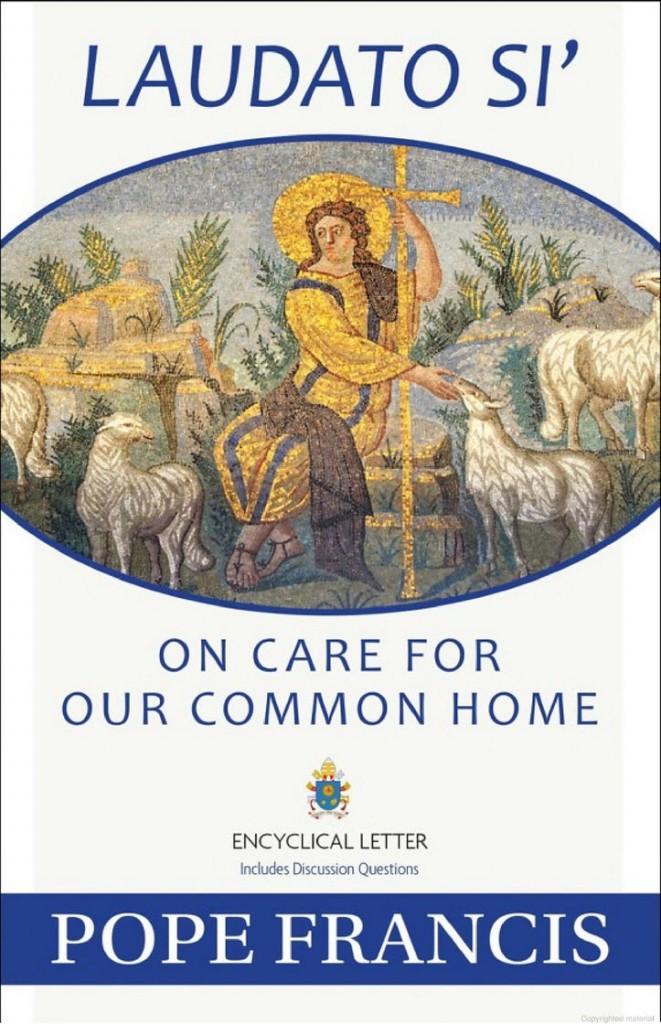In Part I of Walking Before We Fly, I focused on Faith Formation, and on what I should have called Faith Maturation. Children do not choose to be born into a Christian family. We want them to embrace and flourish in it, not be frightened either into it or away from it. That is a challenge, even with adults. In between, we have the teens and young adults, like the girls’ volleyball team helping with food distribution at St. Finbar’s on May 29. Not only were they practicing their faith, but they were in a room full of adults doing the same thing. That reinforces the faith for them, as it did for the adults.
Following up, I agreed to comment on Pope Francis’ encyclical, Laudato Si’ (On Care For Our Common Home). Father Bill said “it is not just recycling.” True, but recycling is like learning to ride the bike (see Part I) toward protecting Mother Earth. If we cannot be bothered recycling, how will we face the big issues—changing our own lifestyles, even if it is inconvenient, and becoming advocates for protecting the environment, even if it is politically unpopular?
The challenge is to avoid being frozen in the fear that the big issues are just too big, and that we cannot make either change. If we focus on how big the challenge is, or if we think that we must get it all done today, we will despair. But we can climb the mountain one step at a time. We can recycle, AND we can push for the world that the Pope envisions.
In that spirit of incrementalism, I would like to offer some introductory thoughts on Laudato Si’. These come from a recent reader of the encyclical, indeed the first encyclical I have ever read. I hope these thoughts encourage others to pick up the encyclical, which Fr. Bill, Fr. John, and Msgr. Al mentioned in successive homilies. In the next installment, I will loosely outline the topics covered in Laudato Si’. In the last installment (I promise, the last), I will conclude with Pope Francis’ challenge to those of us who consume more than our share of the world’s resources, and who, in that process, risk failing to see the interconnectedness of all of creation.
Laudato Si’ is a rigorous 190 pages. Do not be discouraged. It is well worth the investment of time, extremely well-written and generally more accessible than most “religious” writing. Perhaps the book club should take it on.
On the cover of the encyclical is the image of a good shepherd mosaic, circa 425 AD, as shown above. The original is above the entrance to the Mausoleum of Galla Placidia, in Ravenna, Italy. Jesus, the good shepherd, sits outdoors, surrounded by nature, and of course, his sheep. We are also his sheep, but the mosaic depicts four-legged ones.
The introduction to Laudato Si’ explains that, when he was elected the Bishop of Rome, the Pope chose “Francis” as his guide and inspiration because “St. Francis is the example par excellence of care for the vulnerable and of an integral ecology lived out joyfully and authentically.” I see a line connecting St. Francis to the good shepherd in the mosaic, and two more lines connecting Pope Francis to each. The Pope quotes St. Francis’ disciple, St. Bonaventure: “from a reflection on the primary source of all things, [St. Francis] would call creatures, no matter how small, by the name of ‘brother’ or ‘sister’”. The Pope admonishes us not to see this as “naïve romanticism”. Instead, he says: “Saint Francis, faithful to Scripture, invites us to see nature as a magnificent book in which God speaks to us and grants us a glimpse of his infinite beauty and goodness.”
God’s beauty and goodness include everyone and everything, even dirt. A small statue of St. Francis stands in the upper basilica in Assisi. While most art depicting saints shows them looking up to heaven, this statue is looking down at the dirt with awe and wonder, while the Holy Spirit is ascending, as from the earth, not descending from above. See, Richard Rohr, Changing Places, Nov. 15, 2019.
Understanding Laudato Si’ on an emotional and spiritual level should start with appreciating St. Francis through Pope Francis’ eyes. Remaining conscious of and open to that emotional/spiritual base is a valuable compass to keep in your heart while we outline the first five chapters next week.
